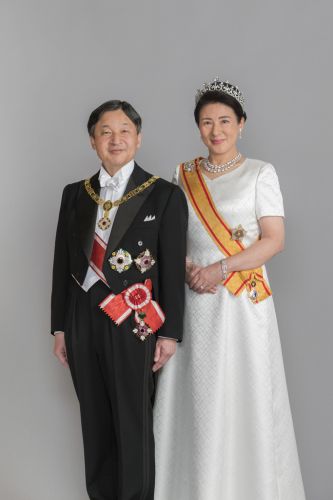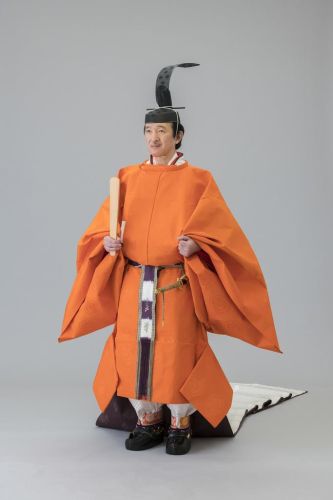Last modified: 14 August 2020
The country
The state is known as Nippon-Koku in its national language. This means the Empire of Japan.
The Empire of Japan is said to have been founded in 660 BC by Emperor Jimmu, who legendary claimed to descend from the sun goddess Amaterasu. After him follow twelve other probably legendary emperors, and one probably legendary empress. The Yamato (Kofun) period produced 14 emperors, who ruled from about 270 to 539. The capital was moved frequently. Afterwards the Asuka period followed from 592 to 715, with ten emperors and five empresses.
A strong central Japanese state for the first time emerged in the Nara period from 715 to 791, with three emperors and two empresses (one reigning twice). In 710 the imperial court was established in Heijõ-kyõ (now Nara). During this period the emperors struggled for power with the Buddhist clergy and the Fujiwara regents. Since this period the emperor hasn’t had actual political power. The Heian period lasted from 781 to 1198. In this time there were 33 emperors. The capital was moved briefly to Nagaoka-kyõ by Emperor Kammu in 784, before moving to Heian-kyõ (Kyoto) in 794 for over one thousand years.
The Kamakura period from 1198 to 1339 had 14 emperors. Between 1331 and 1392 there was a northern court with six seperate emperors. The courts were then reunited. The Muromachi period lasted from 1339 to 1611, with eleven emperors. The Edo period followed from 1611 to 1867, with fourteen emperors. Six non-imperial famlies have controlled the Japanese emperors during this time: the Soga (530s-645), the Fujiwara (850s-1070), the Taira (shortly), the Minamoto (1192-1333), the Ashikaga (1336-1565) and the Tokugawa (1603-1867). At the end of the 12th century conflicts between these clans of aristocratic families and military clans turned into a civil war. At the end a society emerged, dominated by powerful regional families (daimyo) and samurai clans under the political rule of the shogun (warlord). Each Shogun of the last three families had to be officially recognised by the emperor. An Emperor couldn’t exercise power without a shogun, but the emperor was mostly kept to a de jure figurehead ruling position. Apart from a Dutch trading post in Nagasaki, Japan was under self-imposed isolation from the rest of the world from 1635 until about 1867.
At the end of the 19th century and early 20th century Japan was involved in wars with China and Russia. In WW I the country extended its influence in Asia. A second war with China started in 1937. Japan entered WW II in 1941, on the side of Germany. Japan invaded and captured most of the coastal Chinese cities, French Indochina, British Malaya and the Dutch East Indies. After the end of WW II Japan lost all its overseas possessions.
Sovereign
The current sovereign is Naruhito, 126th Emperor (Tennõ) of Japan. He was born the Togu Palace, Tokyo, Japan, on 23 February 1960.
He is the son of Emperor Akihito (Shõwa) of Japan (1933-) and his wife Empress Michiko née Shoda (1934-)
Enthronement
Naruhito became Crown Prince on 23 February 1991. Until then he was titled Prince Hiro. Naruhito succeeded his father upon his abdication on 1 May 2019.
The new Emperor was installed at the State Room of the Imperial Palace, Tokyo, Japan, on 22 October 2019.
Other details
The Emperor’s religion is Shinto.
Marriage and descendants
He is married to Masako Owada (born 1963) since 1993.
Their children:
- Aiko, Princess Toshi (born 2001).
Heir to the throne
Crown Prince Fumihito was born in the Imperial Household Agency Hospital, Imperial Palace, Tokyo, Japan, on 30 November 1965. Fumihito’s childhood title was Prince Aya. He became Prince Akishino upon his marriage. He became Crown Prince on 1 May 2019 and was officially installed on 8 November 2020.
He is the son of Emperor Akihito (Shõwa) of Japan (1933-) and his wife Empress Michiko née Shoda (1934-)
He is married to Kiko Kawashima (born 1966) since 1990.
Their children:
- Princess Mako (born 1990)
- Princess Kako (born 1994)
- Prince Hisahito (born 2006).
Postal address
The Imperial Household Agency
1-1 Chiyoda
Chiyoda-ku
Tokyo
Japan 100-8111
Succession
Japan is a constitutional monarchy. The power of the Emperor is very limited. His role is mainly ceremonial, and he is the symbol of the state and of the unity of the people.
Until the Taishõ period (1912-1926) the emperor could, apart from the Empress, take several secondary consorts (concubines) of various hierarchical degrees. The concubines mainly came from lesser noble families. Also other dynasts were allowed to have concubines. The Empress, Until Emperor Shõmu (701-756) had to be a member of the imperial dynasty, so that even half-siblings or uncle and niece could marry. It was thought this would preserve the imperial blood better or were aimed at producing children symbolic of a reconciliation between two branches of the imperial family. Afterwards the Empress was often a woman from one of the five Fujiwara families (Ichijo, Kujo, Nijo, Konoe, Takatsukasa) or a woman from the imperial family. In 1889 it was even written in the imperial house laws that daughters of the Fujiwara and daughters of the imperial family were primarily acceptable brides. The law was repealed shortly after World War II. Emperor Akihito was the first Crown Prince for more than thousand years to take a wife outside the eligible circle.
Children of the Empress were preferred in succession over sons of secondary consorts. Sons of secondary consorts were however usually recognised as imperial princes and could even be recognised as heir to the throne if the Empress didn’t give birth to an heir. In the past there was an own peculiar system of hereditary succession, which was non- primogenitural, but more or less agnatic. It was mostly based on rotation. Women were allowed to succeed. If she had a child, the father was always an agnate of the imperial house as far as recorded. Adoption was possible and used to increase the number of heirs who were entitled to succeed. They however had to be the child of another member agnate of the imperial house. In the past an Emperor could ascend the throne relatively young. If a dynast had passed his toddler years he was regarded suitable and old enough.
The Salic law, agnatic primogeniture, was adopted from Prussia in the 1870s. According to the Meiji Constitution of 1889 the Imperial Throne shall be succeeded to by imperial male descendants, according to the provisions of the Imperial House Law. Female descendants were thus excluded from succession. In case the main line would become extinct, the throne would pass to the nearest collateral branch, again in the male line. According to the present Japanese constitution the Imperial Throne shall be dynastic and succeeded to in accordance with the Imperial Household Law passed by the Diet. Only legitimate male descendants in male line can be dynasts. Imperial princes and princesses lose their status as Imperial Family members if they marry outside the Imperial Family. An Emperor and other members of the Imperial Family are not allowed to adopt children. Branches, other than the branch descending from Emperor Taisho (1912-1926), are no longer imperial princes. On January 3rd, 2007 a proposal to alter the Imperial Household Law, and allow females to ascend the Japanese throne, was dropped. When the heir is suffering from an incurable disease of mind or body the order of succession may be changed by decision of the Imperial Household Council. A regent will be installed in case an emperor is affected with a serious mental or physical disease, or in case an emperor is a minor (majority is reached at the age of 18). The regent shall be a member of the imperial family: 1) Kotaishi or Kotaison, 2) an imperial prince or prince of the blood, 3) the Empress, 4) the Empress Dowager, 5) the Grand Empress Dowager, 6) an imperial princess or a princess of the blood. The regent might be changed by the Imperial Household Council, in case of a serious disease of the regent.
Titles
The Emperor (Tennõ) is styled His Imperial Majesty (Heika). After his death he receives a new name. The same counts for the Empress (Kogõ), who is styled Her Imperial Majesty. The Empress Dowager (Kõtaigo) and the Grand Empress Dowager (Tai Kõtaigo) are also styled Her Imperial Majesty. The Crown Prince (Kotaishi) is styled His Imperial Highness. In case the Emperor has no son anymore, his grandson will become the imperial heir (Kotaison). The legitimate sons and grandsons in male line are imperial prince (Shinnõ), and are styled His Imperial Highness (Hidenka). Their consorts (shinnõ-hi) are Her Imperial Highness (Hidenka). The legitimate daughters and granddaughters of an emperor in male line are imperial princesses (Naishinnõ), and are styled Her Imperial Highness (Hidenka). Great-grandchildren of an Emperor, and more distant relatives in legitimate male line are princes of the blood (õ), and are styled His Imperial Highness (Hidenka). Their consorts (õ-hi) and princesses of the blood (Nyoõ) are styled Her Imperial Highness (Hidenka).In case a prince of the blood (õ) suceeds to the throne, his brothers and sisters who are prince(ss) of the blood will be granted the title of imperial prince(ss). Sons and daughters of an emperor and of a crown prince receive a personal title upon birth: (title)-no-miya (first name) shinnõ/Naishinnõ). The sons and grandsons usually receive a new title upon their marriage.
A marriage of a male member of the imperial family has to pass the Imperial Household Council. When a woman marries into the imperial family, she loses her surname and takes the female version of the title of her husband. If members of the imperial family leave their status, they take a surname. Princesses who marry a commoner, take their husband’s surname. Princes who renounce their membership of the imperial family usually adopt a surname derived from their former title. The Imperial Household Council might decided that his descendants don’t lose their status as member of the imperial family. A female, who is originally not a member of the imperial family, and who is married to an imperial prince or a prince of the blood can leave her status of member of the imperial family upon the loss of her husband, if she wishes. If a female, who is originally not a member of the imperial family, divorces her husband, she will lose her status as member of the imperial family.
The Emperors of Japan in modern times
| Meiji (Mutsuhito) (1852-1912) | 1867-1912 |
| Taishõ (Yoshihito) (1879-1926) | 1912-1926 |
| Shõwa (Hirohito) (1901-1989) | 1926-1989 |
| Akihito (1933- ) | 1989-abd. 2019 |
| Naruhito (1960-) | 2019- |


